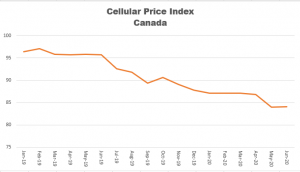Last week, Canada’s Minister of Innovation, Science and Industry, Navdeep Bains, released the first quarterly report tracking the progress of wireless prices from the major service providers.

At the time the tracking was launched, I had said the government should “Declare victory. Consumers are winning.” Prices had already fallen significantly.
But that train had already left the station, and so we are left with a new reporting structure, tracking prices by province each month, releasing the results each quarter, with pricing targets set for 2GB, 4GB and 6GB plans offered by Bell, TELUS and Rogers and their flanker brands.
The press release explains that tracking is restricted to these service providers because they collectively have 90% of the national market. It doesn’t really explain leaving out tracking of significant service providers in individual provinces, such as SaskTel’s majority share in its home province.
There are other problems with the study, most significantly, limiting targets to specific 2GB, 4GB and 6GB plans. Two years ago, Canadians with mobile data plans were already using an average of more than 2.5 GB per month and the CRTC observed that in 2018, “Approximately 40% of data subscribers had a plan with 5 or more gigabytes (GB) of data”. The latest monitoring report showed mobile data consumption per subscriber climbing year over year by nearly 25%.
What happens to the political targets if (or more likely, when) service providers determine that they aren’t offering such packages because low data buckets are no longer in demand?
Interestingly, Canada’s official statistical agency, Statistics Canada produces a Cellular Price Index. Strangely, Statistics Canada doesn’t publish the Cellular Price Index; it is released on demand. The most recent report (released July 22) shows prices declining more than 12% in the twelve month period ending in June 2020. In other words, pricing is already falling at the pace sought during the political campaign (25% over 2 years).
As I said, “Declare victory. Consumers are winning.”
Statistics Canada says its mission is “Serving Canada with high-quality statistical information that matters.” Defining what it does, the agency says:
Statistics Canada produces statistics that help Canadians better understand their country—its population, resources, economy, society and culture.
In addition to conducting a Census every five years, there are about 350 active surveys on virtually all aspects of Canadian life.
In Canada, providing statistics is a federal responsibility. As Canada’s central statistical office, Statistics Canada is legislated to serve this function for the whole of Canada and each of the provinces and territories.
Objective statistical information is vital to an open and democratic society. It provides a solid foundation for informed decisions by elected representatives, businesses, unions and non-profit organizations, as well as individual Canadians.
Statistics Canada falls under the responsibility of Minister Bains, just as he restored the long form census in his very first day in office and introduced other census reforms a couple weeks ago.
Why is there a duplication of effort tracking mobile service prices? Indeed, if we include the price tracking in the CRTC’s Communications Monitoring Report, there are at least 3 different ways mobile price trends are being tracked and reported by Canadian governmental agencies.
Why isn’t “high quality statistical information” from Statistics Canada data being used to measure progress on mobile pricing?
While I disagreed with the government moving the goalposts and setting pricing targets for the mobile industry, it seems wrong for three different groups, all under the Minister’s purview, to be tracking pricing data.
We should be asking what is wrong with Statistics Canada applying its objective methodologies to collect and report on mobile price plan data?
As Statistics Canada says, aren’t objective, reliable, consistent data important for “informed decisions by elected representatives”?
